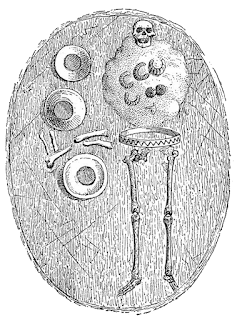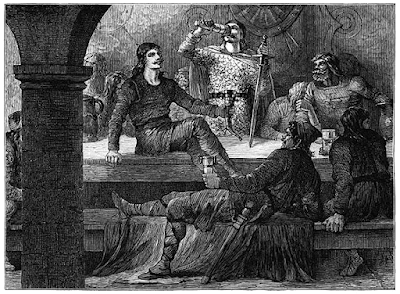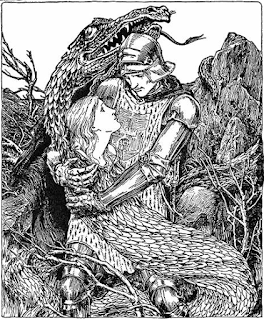Don't split the party.
It's sage wisdom that is passed down from generation to generation of
gamers.
Of course it is - isn't it?
In that - in the OSR sphere especially - encounters are not guaranteed to be
balanced (almost guaranteed to be the opposite, in truth) splitting the party
may not be a bad thing after all for a crafty party. Why shouldn't the
characters with infravision scout ahead down the hall, making sure nothing is
spying from the far side, while the Thief works on that door lock? Or, knowing
that there is a back door to the Deep Dwarf's throne room, why not send the
Assassins around behind while the party face distracts the guards at the main
entrance?
Knowing that splitting the party, while not always the right solution, is
definitely at times a viable if not a preferable strategy, at the end of the
day - the biggest reason you don't split the party as a courtesy. It's an
invitation to split the attention of the ref: who may not handle it - leaving
the one part of the party out in the cold while keeping the grill hot on the
other. In this post, I explore some of my own experiences with split parties,
combined with some of the wisdom of other old-school enthusiasts I've either
conversed with or with whom I've had the pleasure of gaming, in order to
produce a guide: a handful of tricks and tips about how to handle a split
party - how to, with procedures and practice, keep the players engaged, keep
the game moving, and to buck the age-old adage.
Exploration
Exploration: the phase of the game where the party maps out un-mapped portions
of the dungeon - dodges the traps and cracks the locks on treasure vaults
while peering warily into the gloom just beyond their torch light! This phase
of the game - both within the OSR sphere and out - is the easiest part of the
experience to run with a split party.
An OSR game - defined here as a game in keeping with the tonal and mechanical
tendencies of Gary-era TSR Dungeons & Dragons - will by necessity have
procedural elements used for the tracking of time and the measurement of
activity in the dungeon. Picking a lock? Takes a turn. Checking for traps?
Takes a turn. In this manner - the referee is able to adequately measure when
to check for wandering monsters, how long a torch lasts, and similar:
producing a ticking clock and balance of urgency to the players. How long
before resources run out - and how much deeper can we go to find that next
gold piece? The key to running a split party in this context is to lean on
those procedures: alternating turns as to who is up to bat the same as you
would for a combat.

From my own dungeon-mastering past: a party once encountered a very trite
shrine of elements - where a key to get into the center had to be obtained
from two wings, pocket dimensions, one being arid and rocky - the other being
marshy and wet. I forget why they were different - but the point is the
party - being eight strong or so with some redundancy of roles - decided to
break into groups of four and tackle both at the same time. Not a problem!
Both wings of the map were relatively small "dungeon levels" - they had short
maps, mostly corridors, maze theme - so I noted the movement rates of the two
sub-parties and, every that number of feet they explored, I would cut scene
back to the other party - turn by turn, working their way into the heart of
the maze. By switching back and forth - by keeping both sub-parties involved
and relevant in the current turn of events, the players remain invested and
attentive... or, as attentive as they are wont to be, but player caliber is a
separate consideration.
In a non-OSR game, you can accomplish the same thing with progress points:
think milestones, except for in-dungeon tasks. If one sub-party is attempting
to open a door and they successfully pick a lock? That would be a progress
point - before the door swings open, switch over to the other sub-party. One
sub-party moves down a corridor, coming to a junction where they must choose
which way to go? Progress point.
Arguably, in the progress-point scenario, all we've really done is introduced
a procedure where there was none before: albeit a more seat-of-pants or
wish-wash version than the concrete procedures associated with a B/X or OSR
style game. Also arguably - who, reading this blog of all things,
isn't playing an OSR game? Food for thought, either way.
Additionally - consider a caller. A caller helps - either way you do it - when
running a split party in an exploration mode in that it allows the sub-parties
to discuss among themselves what they're doing. In voice chat - admittedly -
this is difficult: as the cross-talk is level compared to the ability to
cross-chat at a table, where it's directional - but in an online sphere,
there's also nothing preventing the sub-party players from pinging each other
in instant messages. I.M. is slower than voice, of course: but really, there
likely won't be that much conversation going on between them between turns -
as how much can you really discuss when you're orders are along the lines of
"We move 80 feet down the corridor and the Thief taps the walls for secret
entrances"?
Combat
What happens when one of two (or more) sub-parties then enters a combat
encounter? Wandering monsters happen, rooms sometimes contain aggressive
monsters; combat is part of the experience.
To start with what
not to do, do
not simply run the combat,
forcing the uninvolved sub-party to twiddle their thumbs until the encounter
ends; second, do not try to mix turns: an exploration turn (which is what the
other sub-party will be doing) is worth 10 combat rounds - so either you will
have a twiddle-their-thumbs scenario for 10 rounds followed by a "what are we
doing?" turn, iterate for the duration of the combat encounter. So, with those
two out - what
do you do? I have experienced with a few options, some of
which work better than others.
The easiest thing to run - and unfortunately the least likely to occur without
the use of quantum ogres or other railroad-esque mechanism - is to engage in
two separate combats. However in a populous dungeon - it may be a viable
option. In the same game from above, talking about one party going to an arid
mini-dungeon and another going to a swampy one, there was a planned encounter
- a guardian - in the swampy subdomain: an aquatic creature would follow the
party and assess them, engaging when it felt appropriate or when the party
spotted it. That contingency had started - it was following the characters who
were exploring that half of the map - but it had not yet engaged: on the other
side, the other half of the party got the drop on some elemental rock
creatures. The sub-party engaged the elementals from range, starting a combat.
At that time - it did not seem particularly quantum ogre of me to do so - but
I said, "We'll do one exploration turn over here, before we start in on the
combat, and will get back to it." In that one exploration turn, the guardian
in the water engaged - the other sub-party embroiled in combat - and from
there, I was able to go round by round with each side: with the exception that
the two sub-parties could not help each other when things went south (which,
for the swamp-party, they did), the experience played out like a normal
combat. After the session, I expected to be accused of coercing the encounter
- but I guess the players had enough fun during the session that, at our
midnight Waffle House post-session follow-up, they were instead talking about
plans as to what to do the next session - where they wanted to use the newly
discovered key to delve into the main temple.
Alternatively, presuming the presence of henchmen as participants in the
combat, there is always the option that missing players could take on the role
of the henchmen for the duration of the combat encounter. This would keep the
sub-party players relevant to the activity at hand - participating in the
combat - while also keeping the split dynamics intact. I have not done this
with a split party before - however I have done similar regarding the
replacement of player characters. While it's long-standing tradition to step
into the shoes of your henchman if your main character dies, what happens when
you run out of henchmen? Well, git gud, obviously: but - from a more serious
tone in play experience - my groups tend to lend henchmen around. "Is it OK
for Soinso to take over Whosit?" "Sure - go ahead my man." And the game moves
on. However - in those games - henchmen tended to be more a party resource
than a player resource: it requires that the one player doesn't have an
investment in those henchmen and it requires that the other takes care to act
in kind with how the first played their henchman in the first place. So this
solution may not work for all groups - especially if the henchman in question
has leveled with the party rather than being a more one-off style NPC
accompanying the group for a cut of the treasure.
A third option - my personal favorite: have the sub-party not engaged in the
combat play the bad guys in the combat. I don't claim to have originated the
idea: having read about someone else trying it having inspired this article -
but I do know I've done it at least once; more specifically, having done it
with a group while running the Lichway: one sub-party was a set of player
characters, the other sub-party playing NPC bad guys including the
Artist/Jailer in that central room. Save the champion or leader of the bad
guys for yourself - if appropriate - as the ref and then tell the other party
it's time to attack their friends. Again - this serves the goal of keeping the
other players, the other sub-party, engaged during an assymetric fight.
Admittedly, some parties may not like the idea - they may not enjoy a PvP
aspect; and alternatively, some parties may try to take advantage of the
situation - playing the monsters poorly to give their allies an advantage.
From my experience, it was the opposite - the players being friends in real
life relished the opportunity to beat each other up in game, going so
far as to taunt one another pseudo-in-character all the while: but you will
need to judge whether this approach is going to work for you - as to whether
your players are going to enjoy it, to thrive in the spirit of it like mine
did, or whether they won't.

Could I just let the other party rejoin the combat? Sure. If the other
side of the party is within a reasonable distance, I would have the roll to
Hear Noise and - if they succeed - allow them to make the call to come to the
aid of their fellows. If they are too far - so be it - but if they are close
enough, go into combat rounds and have them charge through the halls
(remembering to check for traps along the way) and come into combat. If it
will take more than three rounds, however, I recommend one of the other steps
above in the meantime - again, the name of the game being to keep the players
- all of them - in the moment and engrossed in the game.
Role Play
Role play elements - elements which have less of a procedure, less framework
around them - therein lies the most challenging to keep split parties engaged.
But first - a definition:
Role play doesn't mean talking in your character's voice.
Role play doesn't mean making a bad decision because "that's what my
character would do."
For the context of this conversation, role play is the injection of the self
into the avatar of the character: your thoughts are their thoughts, your words
are their words, and your actions are their actions. Thus, it does mean
that you will speak the words your character is speaking - I joke that
character voices aren't for me; that's true, but the joke is that I'm not
everyone: if character voices work for you, use them! - it also means
interacting with that puzzle room. It also means solving that intricate trap.
Why depend on a Thief to produce a number on a percentile roll when you could
interact with the environment?
That said - elements of in-character activity that involve intense or focused
involvement by the player will, in a split party scenario, by necessity
exclude the other sub-party. The key - however - in keeping that sub-party
involved, keeping those players relevant to the action - is the same as during
exploration: swapping turns. Recall that a game turn is generally 10 minutes:
as such, in a role-play encounter, interacting with the environment or NPCs
over the course of 10 minutes should constitute a full turn: entitling the
other party to a turn of their own.

But 10 minutes is a long time to ask the party-splitters to pay attention. Yes - it is. And at this point, it's good to leverage the power of
abstraction. Players not having necessarily the best sense of time -
especially when immersed in the moment - you could start by aiming at the five
minute mark. Five minutes is fair - it's within the realm of reason when
keeping the attention of the split-party - but it's also close enough that you
can point out, well - yes, 10 game minutes have taken 5 in-real-life ones, but
the words exchanged, the gestures made - they may not have been one to one. In
the same sense that a combat round takes far more time at the table than in
the game, and in the same sense that an exploration turn takes far less time
at the table than in the game, it tracks that this timetable doesn't need to
track, itself, one to one with the passage of time in the game.
You will need to hone the time to your table. Some tables will handle 5
minutes well, but 7 minutes better; other tables may be able to go to the full
10. If your group can manage 10 minutes? Go for it! There is no reason not to
if the players are engaged. What I would say - though - is be consistent. Once
the cadence is established, stick to it: as it will help the players (and help
you as the referee) fall into habit: creating and adhering to a procedure in
an otherwise largely procedure-less circumstance.
Radio Grognard recently had an episode
- or, within the last month or so had an episode... - where Glen talked about
having a timer at the table - an hourglass or other non-invasive type - to
help with pacing. That's brilliant advice - for the new referee and the
seasoned referee alike: for the newbie, helping to get to that pacing place;
for the veteran, helping to keep to a rhythm.
In the meanwhile, don't forget - it is important to stay between 5 and 10
minutes. If you go outside of those bounds, if not only for engagement factor,
you'll be cheating the players - either for or against - when it comes to
wandering monsters appearing or for torches slowly running low.
Conclusion
And them's my two coppers.
Have you done it better? I'd like to hear about it! Drop me a line - a
comment, an email, a Discord direct message, or a voicemail over on
the podcast. But whatever you do - don't fail to keep exploring!
Delve on, readers.
Public domain artwork retrieved from
OldBookIllustrations.com
and the
National Gallery of Art
and adapted for thematic use. Attributions in alt text.



















